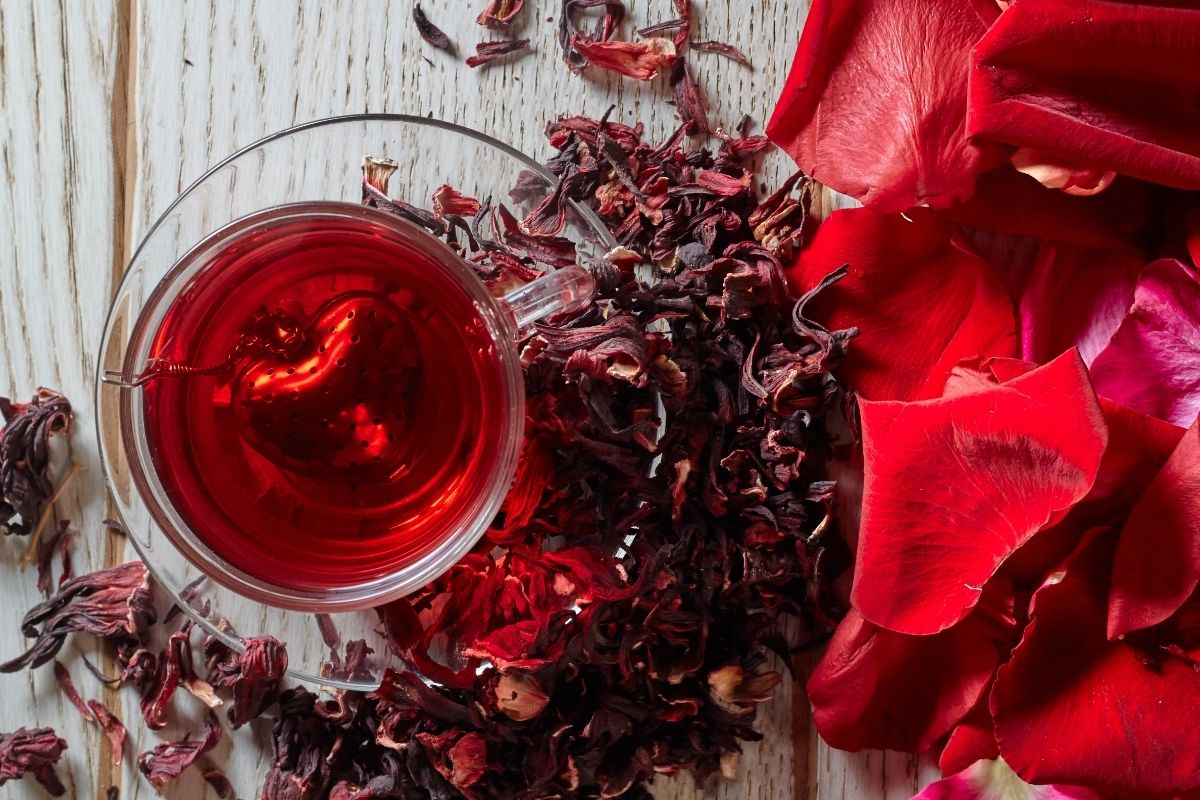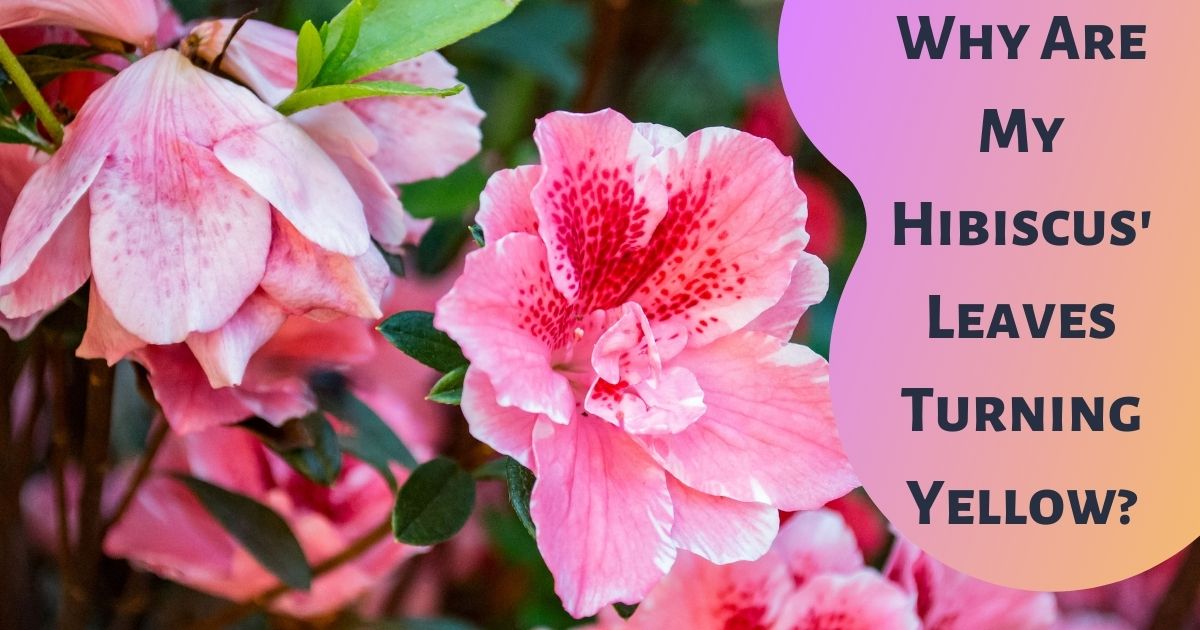What is a Hibiscus?
Hibiscus has many benefits, but that doesn’t mean it’s without its issues since hibiscus leaves turning yellow are among some of the common hibiscus problems most gardeners face.
Hibiscus plants are flowering plants with many species, but the three main varieties include hardy hibiscus, rose of Sharon, and tropical hibiscus. Did you know that hibiscus tea has many names in countries worldwide and gets served both hot and cold?

What Causes Hibiscus Leaves to Turn Yellow?
The size and color of hibiscus flowers and leaves vary depending on the species, but healthy hibiscus plants have green leaves with large, colorful flowers. If your hibiscus plant has a few yellow leaves here and there, it’s nothing to worry about, as the plants usually renew their leaves by yellowing and dropping the old ones.
However, if most of the hibiscus plant leaves are yellow, and the plant looks wilted, it’s a sign that something’s not right.
Many factors contribute to hibiscus leaves turning yellow, and if your hibiscus plant leaves are turning yellow, it means your plants are signaling for a specific need to get met. It is, therefore, necessary to acquaint yourself with the factors listed below to allow you to fix the underlying issues before they become a problem for your plant.
Inadequate Light
Hibiscus plants are tropical plants, and as tropical plants, they need full sun to partial shade to survive and thrive. Hibiscus leaves can therefore turn yellow if they are not receiving enough light. Conversely, too much direct sunlight can also result in yellowing the leaves and leaf sunburn, which will cause the foliage to develop little white spots.
Soil
Poor soil conditions like poor drainage, soil compaction, or even lack of soil can cause the leaves of your Hibiscus plant to turn yellow. This is because these conditions contribute to water issues.
Ensure your soil is well aerated and keep your soil’s pH slightly on the acidic side to prevent yellow leaves in your hibiscus plant. If your hibiscus needs repotting, use a light, well-draining potting mix or soilless medium. Remember not to plant too big a pot, as hibiscus likes to be a bit crowded.
Water
Hibiscus plants, like most tropical plants, require a lot of water. However, too much or too little water is a primary cause of yellowing in hibiscus leaves. Overwatering can lead to root rot as well.
To ensure your plant is getting enough water, check the soil every day or two by poking your finger into the top inch (2.5 centimeters) or so. The dirt should feel slightly moist, not wet. When it begins to feel dry, it’s time to water.
How Often Do You Water Hibiscus?
Tropical hibiscus plants need a lot of water, so regular watering is essential to keep the soil moist, especially during the summertime. A layer of mulch at the base of an outdoor plant can help retain soil moisture. The idea is to maintain consistently moist soil around hibiscus plants to promote proper growth and prevent the yellowing of leaves.
How to Care for Hibiscus
Every gardener must take into consideration how to care for hibiscus plants. While hibiscus plants can be a little bit needier than some other popular flowers, once you’ve identified the cause of the problem, use these tips to get your plants back on track.
Correct Problem
Once you know what the problem is, fix it. Make sure to change the conditions causing problems to encourage growth. Then, implement the necessary changes (move, transplant, or protect) in your hibiscus plant to keep the growing conditions as stable as possible.
Pruning
After identifying and correcting the problem causing the yellowing of leaves in your hibiscus plants, your plant should begin to sprout new leaves. To ensure they grow back correctly, you may want to trim some of the branches (the bare branches) to reduce water and nutrient needs as your plant recovers.
What You Can Do With Hibiscus After Harvesting
There are several uses for hibiscus after harvesting. The most common use of hibiscus after harvesting is for making tea. Research has uncovered a range of health benefits linked to drinking hibiscus tea, showing that it may lower blood pressure, fight bacteria and even aid weight loss.
What Does Healthy Hibiscus Plant Leaves Look Like?
Hibiscus plant leaves will usually have two different shades of green on their lower and upper surfaces, with the upper surface a brighter green than the lower.
The color and size of hibiscus flowers and foliage vary depending on the species, but generally speaking, healthy hibiscus plants have green leaves with large, colorful flowers. Hibiscus leaves consist of more than 85 percent water.

Common Hibiscus Problems Debunked
Hibiscus growers usually do everything to ensure their plants are healthy and pest-free. Hence, answers to questions like how often do you water hibiscus? Does hibiscus like acidic soil? Why are my potted hibiscus leaves turning yellow? Are you necessary to debunk common hibiscus problems?
Do Hibiscus Like Acidic Soil?
The most straightforward answer to the question “does hibiscus like acidic soil?” is yes! Hibiscus grows best in slightly acidic soil with a pH of between 6.5 and 6.8. Before planting, determine your soil’s pH by testing it. Lime is commonly used to raise pH, and soil sulfur decreases it.
Why is My Hibiscus Losing Leaves?
For most plants, leaf drop is a common problem. While it is expected for most plants to shed leaves in the season (autumn), it is pretty troubling when this happens out of season.
This can be very frustrating when you have done everything necessary for your plant, and the leaves keep dropping. Below are some of the reasons that answer the question, “why is my hibiscus losing leaves?
Transplanting
Leaf drop is a common symptom of transplant shock. Plants like hibiscus often shed leaves when they are repotted or transplanted. However, the shock will pass once the hibiscus plant begins to adjust to its new environment.
Temperature
Exposing your hibiscus plant to extreme temperature changes can be pretty stressful for the plant. This stress usually causes the leaves of the plant to drop. You can simply remedy this by controlling temperature changes.
Water
Hibiscus leaf drop can be a symptom of too much or too little water, as well as inadequate drainage. To prevent leaf drops in the hibiscus plants, you should ensure your plants have the right amount of water (keep in mind the season) to ensure growth.
How to Treat Hibiscus Leaves Yellowing
In most hibiscus plants, yellowing leaves are a common problem. To treat this, proper hibiscus care can prevent wilting, encourage new growth, and keep your entire plant healthy. The following care tips can help your plant grow properly.
Protect Your hibiscus from Harsh Conditions
Increase watering during extreme temperatures (e.g., heatwave) to ensure that your plant has enough water. If you live in a temperate climate, move your potted hibiscus indoors during the cold winter months.
Regulate Sunlight
Hibiscus plants need plenty of full sun but should get protected from direct sunlight during the hottest part of the day. If the leaves are yellowing, move the plant to an area where it can receive full sun in the morning and shade in the afternoon.
Maintain the Right Soil Conditions
Consistent watering is crucial to keep the soil sufficiently moist, especially during the summertime growing season. Make sure that potted plants are in well-draining soil. Houseplants stay in pots with drainage holes to avoid soaking and damaging the root system.
Preventing Yellow Leaves in Hibiscus
There are several ways to prevent your hibiscus plant leaves from turning yellow. As long as you maintain the right amount of moisture, light, and nutrient-rich soil, you really shouldn’t have too many issues with your hibiscus plants. As a rule of thumb, ensuring the following practices get carried out will go a long way in preventing yellow leaves in hibiscus.
Improve the Soil Quality by Adding Manure
Add compost, leaf mold, and manure (well-rotted) to the soil around the hibiscus plant to improve the soil moisture and quality. If the soil tends to dry, apply these things twice a year, once in spring and again in the middle of summer.
Keep the Soil Moist
Hibiscus plants prefer moist soil and well-aerated soils. If the soil dries, the leaves start to turn yellow. Keep the soil moist and water the plant as required to prevent this from happening. Watering your plants once a week is often required to protect them from yellow leaves, but if the climate is dry and hot, more watering is required to keep the soil moist.
Protect the Plant from Excess Wind
Excess wind decreases the humidity in the air, and since hibiscus plants are native to tropical regions, they require more humidity. This adversely affects their growth and often results in the yellowing of leaves. Planting other shrubs around the tree acts as a wind buffer and shelters the plant from high wind.

Yellow – Not so Mellow!
Tropical hibiscus plants are vulnerable to environmental changes. Therefore, it is necessary to provide adequate care and attention to ensure they grow in optimal conditions. Hibiscus leaves turning yellow and falling off are primarily because of drought stress, over-watering, insects, and unbalanced fertilizers in the soil.
The sudden temperature change can cause hibiscus leaves to turn yellow, and so can the lack of direct sun.
To revive and care for hibiscus, it is essential to recreate the conditions in which they thrive in their native habitat with full sun, lots of moisture, good drainage, and nutrient-rich soil.
